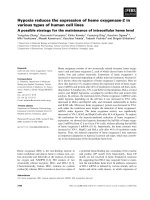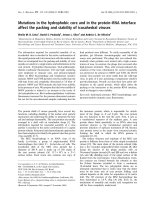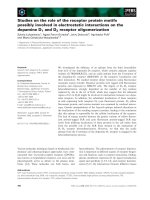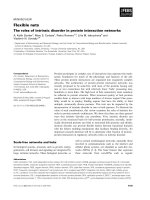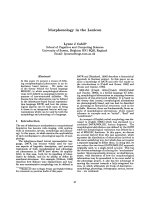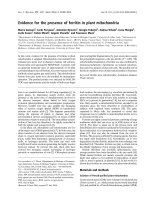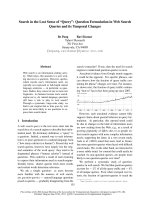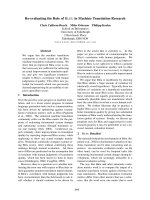Báo cáo khoa học: Dynamics in the transmission of genetic information: from meiosis to postmeiotic events doc
Bạn đang xem bản rút gọn của tài liệu. Xem và tải ngay bản đầy đủ của tài liệu tại đây (78.92 KB, 1 trang )
MINIREVIEW SERIES
Dynamics in the transmission of genetic information: from
meiosis to postmeiotic events
Wataru Kagawa and Hitoshi Kurumizaka
Graduate School of Advanced Science and Engineering, Waseda University, Tokyo, Japan
Meiosis is a special type of cell division that generates
haploid gametes from diploid parental cells in sexually
reproducing organisms. Meiosis is essential for the
maintenance of a stable chromosome count through
successive generations. Failure would result in zygotes
with an abnormal number of chromosomes, which is
usually lethal to the cell.
During meiosis, homologous chromosomes are
paired together, and meiotic recombination plays a
critical role in this process. Physical connection
between homologous chromosomes is essential for
their accurate segregation, and the ability of the cell to
pair homologous chromosomes during meiosis is
remarkable. Multiple DNA double-strand breaks are
introduced across the entire genome; the DNA strands
with these breaks are then digested by exonucleases to
expose single-stranded regions. The duplex region
homologous to the exposed single-stranded DNA is
then searched for across the genome; this is compli-
cated by the fact that interhomolog recombination is
preferred over recombination between sister chromat-
ids. Many of the mechanisms that underlie the faithful
segregation of chromosomes during meiosis and the
process of packaging and propagating the genomic
DNA to the offspring during the postmeiotic events
are still poorly understood.
Our minireview series starts with the topic of the
recognition of homologous chromosomes. Although
meiotic recombination is critical for the accurate pair-
ing of homologous chromosomes, this process also
involves the global alignment of homologous chromo-
somes. The possible existence of chromosome-specific
identifiers that can recognize homology without
directly comparing DNA sequences is discussed.
The second minireview describes the importance of
meiotic recombination in meiosis, and the current
understanding of this process and its control mecha-
nisms. Imperfections in meiotic recombination have
been linked with de novo germline mutations, abnor-
mal gametes, and infertility. Unexpectedly, this impor-
tant process shows remarkable flexibility in both the
number and distribution of recombination events along
the entire genome. A special emphasis is placed on the
potential role of histone modifications in the distribu-
tion of meiotic recombination sites.
The third topic in this minireview series is the Dmc1
recombinase, which is one of the key players in meiotic
recombination. Recent biochemical and structural
studies of Dmc1 and its homologs have revealed unprec-
edented details of how Dmc1 may catalyze DNA strand
exchange. As Dmc1 and its homolog, Rad51, both
participate in meiotic recombination, these two recom-
binases are expected to have different roles, and thus to
have intrinsic structural and biochemical differences.
Studies are underway to decipher these differences.
The last minireview focuses on the structure of the
haploid chromosome during the postmeiotic phases of
spermatogenesis. Genome-wide compaction and reorga-
nization of the haploid chromosome is known to occur
after meiosis is completed. However, virtually nothing is
known about the mechanisms underlying the genome-
wide replacements of histones with the histone variants
and nonhistone DNA-packaging basic proteins that
occur during the postmeiotic phases of spermatogenesis.
The minireview focuses on the possible roles of histone
variants and modifications in this dynamic event. We
hope that these minireviews will contribute to the field
of meiosis, as well as that of chromatin dynamics.
Wataru Kagawa is an Assistant Professor in the Graduate School of Advanced Science and Engineering at Waseda Uni-
versity. He received his PhD degree from the Department of Biochemistry and Biophysics at the University of Tokyo. He
has performed biochemical and X-ray crystallographic studies on homologous recombination factors, RAD52 and DMC1.
His primary interest is in understanding the relationship between the three-dimensional structures of macromolecules
and their functions in DNA repair, replication, and recombination, using X-ray crystallography as the main tool.
Hitoshi Kurumizaka is a Professor in the Graduate School of Advanced Science and Engineering at Waseda University.
He received his PhD degree from Saitama University under the supervision of Dr Takehiko Shibata. He studied
the molecular mechanisms of homologous recombination. Dr Kurumizaka joined Dr Alan P. Wolffe’s laboratory at the
National Institutes of Health, USA, as a postdoctoral fellow, where he investigated the roles of chromatin structure in
transcription. He later joined the RIKEN Institute as a research scientist. His current research focuses on the mecha-
nisms of homologous recombination in the context of chromosomal architecture.
doi:10.1111/j.1742-4658.2009.07500.x
564 FEBS Journal 277 (2010) 564 ª 2009 The Authors Journal compilation ª 2009 FEBS

